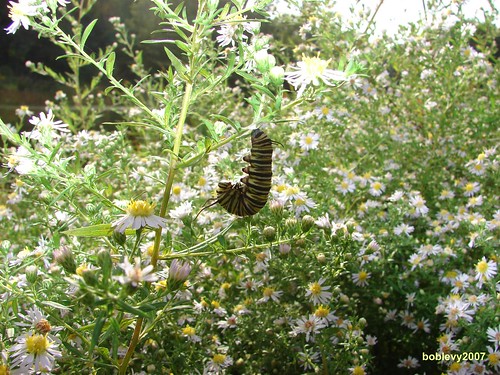tags: butterflies, pupa, insects, Central Park, Image of the Day
The photographer writes; I found this Pupa practitioner of the Yoga arts working out at Turtle Pond in Central Park. Definitely do not try this pose yourself. I suppose the acrobats among you -- especially among those more athletically inclined and adventurous Parrot Pals -- might try for the same result with his or her teeth provided, of course they are not dentures or implants, but for all others I strongly recommend you give it a pass.
More like this
Tenebrio molitor, pupa
Bodyguards have a tough and risky job but they usually get paid for their
Humans aren't the only species that have had to deal with the issue of sl


Looks like a monarch. And would you call that a pupa or a caterpillar?
It's a monarch larva in the process of pupating. They hang upside down from a silk button in "J" position for a while before shedding the last larval cuticle. That molt reveals the classic green-and-gold pupa, although it takes a few hours for it to assume the familiar shape.
I've reared more than a few of the little critters, and they're fun to watch at all stages!
since this beastie is between life stages, i'd guess that it could be referred to as a "pupillar".
Monarch :)
I work at a nature center and we raised tons of 'em this summer. It was a great year for them; in fact they ate all the milkweed in front of the center and we had to relocate over 50 of them.
I do a lot of butterfly gardening - but what I'd like to know is - what is the plant that it is on? We have a lot of it growing and blooming this time of year around our house too, we didn't plant it though so we don't know what it is.
The plant is an aster. This group of wild aster species, at least around the Houston area, come into bloom about now and persist into November. They are a big hit with native bees and also butterflies. I have tried without success to start them from seed. You might consult a wildflower guide for your region.
The usual host plants for monarchs (Danaus plexippus) are milkweeds of the genus Asclepias. A lot of people plant them in gardens to attract the butterflies and the equally spectacular butterflies. My grandmother plants a milkweed called swan plant (A. fruticosa) (because the swollen seed pods together with their curved stem resemble a swan). The plants are toxic, and the caterpillar sequesters the toxins from its host - the bright colours of both caterpillar and butterfly advertise this toxicity.
Thanks biosparite! I have some wildflower guides, I'll look them up.
My husband has managed to propagate them all over, not sure how he did it though.